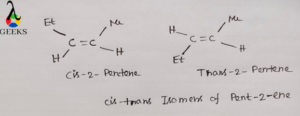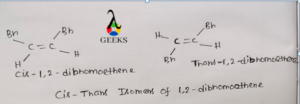Cis-trans isomers are those isomers which have same molecular formula but have different orientation of functional groups in 3D space. In Cis isomer functional group are on the same side of the double bond while in trans isomer they are on the opposite side of the double bond. Cis trans isomers example are a part of structural isomer.
But-2-ene
But-2-ene shows cis-trans isomerism. It’s cis trans isomers example are cis-2-butene and the other is trans-2-butene. In cis-2-butene 2 methyl group is situated on the same side of the double bond while in trans isomer 2 Me group is on opposite position with respect to double bond. But in both isomer 2 methyl groups are attached to sp2 hybridized C atom but not in same C atom.
As cis-2-butene is polar in nature (because,µ≠0) its boiling point is higher than trans-2-butene which is non-polar in nature (µ=0). Also trans isomer has more symmetrical structure than cis isomer, trans-2-butene has higher melting point than cis-2-butene. In terms of stability trans-2-butene is more stable than cis-2-butene due to the fact that in cis isomer there occurs steric crowding between 2 bulky Me groups.

Pent-2-ene
Pent-2-ene shows cis-trans isomerism. It’s cis trans isomers example are cis-2-pentene and the other is trans-2-pentene. In cis isomer Me and Et group is situated on the same side of the double bond while in trans isomer these 2 groups is on opposite position of the double bond. In cis isomer as sp2 hybridized carbon is more electronegative than sp3 hybridized C atom, sp2C-sp3Me bond moment lies towards sp2C and also sp2C-SP3Et bond moment lies towards sp2C.
But in case of trans-2-pentene Me and Et groups is on opposite side of the double bond and these 2 bond moment lies in same direction and cancel each other. Hence its dipole moment is 0. As cis-2-pentene is polar in nature, its boiling point is higher than trans-2-pentene which is non-polar in nature(µ=0). Also trans isomer has more symmetrical structure than cis isomer, trans-2-pentene has higher melting point than cis-2-pentene.

Diazene
Diazene also shows cis-trans isomerism. In cis-diazene 2 lone pair and 2 H atoms are on the same side of the double bond while in trans isomer these are on the opposite direction to each other with respect to double bond. These 2 isomer can be differentiate from each other by their reactivity.
. Cis-diazene is much more reactive than trans diazene due to repulsion between 2 lone pair in cis-diazene increases the lone pair availability towards an alkene. For the same reason cis isomer is less stable than trans isomer. Cis-diazene is more polar than trans-diazene as because 2N-H bond moment lies in the same direction which is in opposite direction in case of trans-diazene making it a non-polar compound.

Hex-3-ene
Hex-2-ene shows cis-trans isomerism. It’s cis trans isomers example are cis-Hex-3-ene and the other is trans-Hex-3-ene. In cis-isomer 2 ethyl group is situated on the same side of the double bond while in trans isomer 2 Et group is on opposite side Of double bond. In cis isomer as sp2 C is more electronegative than sp3 hybridized Me group, 2 sp2C-sp3C bond moment lies towards sp2C i.e. its overall dipole moment is high. But in trans isomer 2 Et group is on opposite side 2 sp2C-sp3C bond moment lies in same direction and cancel each other. Hence its dipole moment is 0.
As cis-Hex-3-ene polar in nature(because,µ≠0) its boiling point is higher than trans-Hex-3-ene which is non-polar in nature(µ=0). Also trans isomer has more symmetrical structure than cis isomer, trans-Hex-3-ene has higher melting point than cis-Hex-3-ene. In terms of stability trans-Hex-3-ene is more stable than cis-Hex-3-ene due to the fact that in cis isomer there occurs steric crowding between 2 bulky Et groups.

1,2-dibromoethene
1,2-dibromoethene shows cis-trans isomerism. It’s cis trans isomers example are cis-1,2-dibromoethene and the other is trans-1,2-dibromoethene. In cis isomer 2 Br group is situated on the same side of the double bond while in trans isomer 2 Br group is on opposite position with respect to double bond. In terms of stability trans isomer is more stable than cis isomer due to the fact that in cis isomer there occurs steric crowding between 2 bulky Br groups.
.In cis isomer as 2 Br group is on the same side of the double bond, 2 C-Br bond moment lies towards Br group i.e. its dipole moment is high. But in trans isomer 2 C-Br bond moment lies in same direction and cancel each other. Hence its dipole moment is 0. As cis isomer is polar in nature, its boiling point is higher than trans isomer which is non-polar in nature. Also trans isomer has more symmetrical structure than cis isomer, trans isomer has higher melting point than cis isomer.


Hi….I am Susanta Maity. I have completed my Masters from Vidyasagar university with a specialization in organic chemistry.
I love to write complicated Chemistry concepts in understandable and simple words.
Let’s connect through LinkedIn: